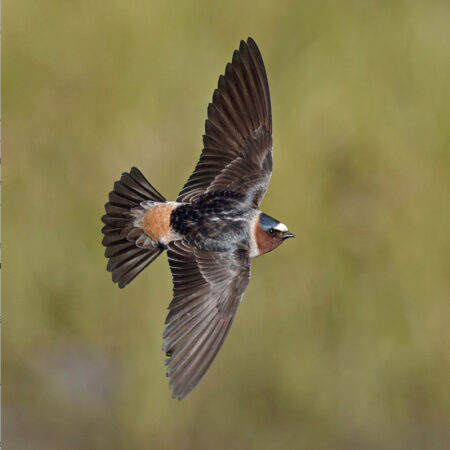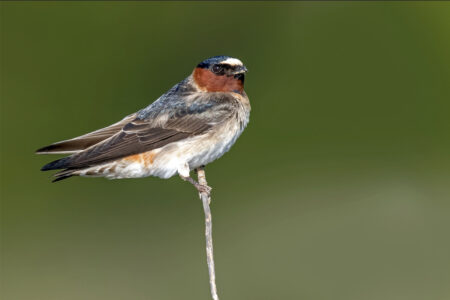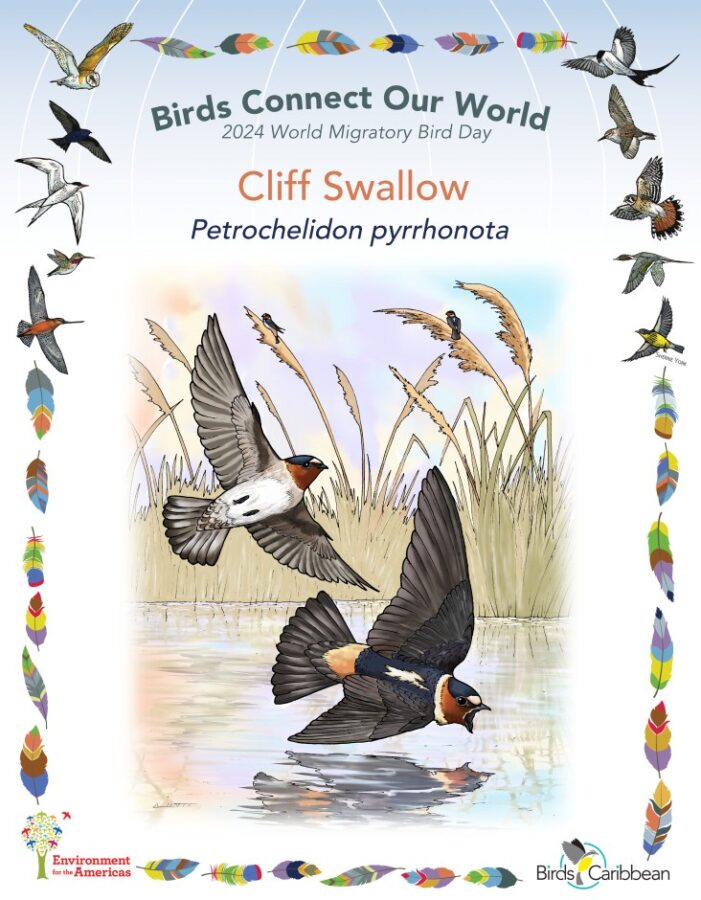Celebrate World Migratory Bird Day (WMBD) with us in 2024! This year’s theme is “Protect Insects, Protect Birds”. Have fun learning about a new migratory bird every day. We have coloring pages, interesting facts, activities, and more. Download for free and enjoy nature with your family at home.
Migratory Bird of the Day: Cliff Swallow
Meet the Cliff Swallow (Petrochelidon pyrrhonota)! The Cliff Swallow is a master of the skies, performing dazzling acrobatics as it hunts for its favorite food—flying insects. Unique among swallows, the Cliff Swallow frequently changes altitude while flying, has a high-speed flight, and often glides with its wings tilted downward.
The Cliff Swallow is a compact swallow with a short, square tail. Its striking plumage features a metallic, dark-blue back and crown, cinnamon-colored neck, pale buffy-orange rump, whitish belly, and bright buff-white forehead patch. Males and females look similar, while juveniles look like a drab version of the adult.
It can be challenging to identify these fast-flying birds, so it’s important to know how they differ from similar species. The Cave Swallow (Petrochelidon fulva) has a paler throat and orange forehead, while the Barn Swallow (Hirundo rustica) has a long deeply forked tail and lacks the Cliff Swallow’s buffy-orange rump.
The Cliff Swallow has a vast range, breeding throughout North America. It winters in and/or passes through many Caribbean islands on migration, traveling as far south as Brazil and Argentina. Its exact distribution in these wintering areas and the migratory routes it follows are not well understood highlighting the need for more research.
Cliff Swallows are highly social, often nesting in colonies that can host up to 6,000 nests at a single site! Historically, they chose natural sites like cliff faces or canyon walls to place their intricate mud nests. But in the last 100 to 150 years, they’ve expanded their range across North America, finding nesting spots on modern structures like bridges, culverts, and buildings.
The social behavior of the Cliff Swallow during the breeding season has been well-studied, helping us understand the evolution of colonial nesting and rapid adaptation to environmental changes both natural and human-made. Their flexibility has allowed them to thrive across North America, even colonizing areas where they hadn’t previously been recorded.
Cliff Swallows migrate through a wide variety of habitats. You can most likely spot them over grasslands, wetlands, and agricultural areas, zooming around acrobatically to catch insects on the wing. You may also spot them perched in trees preening or roosting for the night, or bathing in shallow water.
Although classified as a species of “Least Concern,” conservation actions are still vital to their long-term survival. Reducing pesticide use helps keep their insect food abundant, and participating in citizen science counts aids researchers in tracking migration and population trends — contributing to the protection of this remarkable species.
Learn more about this species, including its range, photos, and calls here. Great news! If you’re in the Caribbean, thanks to BirdsCaribbean, you have free access to Birds of the World and you can find out even more in the full species account of this bird!
Thanks to Alieny González Alfonso for the text and Arnaldo Toledo for the lovely illustration!
Color in the Cliff Swallow
Download the Migratory Birds of the Day Coloring Page! Use the picture above and the photos on this page as your guide, or look up pictures of the bird online or in a bird field guide if you have one. Share your colored-in page with us by posting it online and tagging us @BirdsCaribbean #WMBD2024Carib
Listen to the calls of the Cliff Swallow
The calls of the Cliff Swallow are a short, repeated “chur”.
Enjoy these photos of Cliff Swallows


Activity of the Day
 FOR KIDS: Use your observation skills and go on a migratory birds and insect Scavenger hunt! Print the cards on sturdy paper and use a clipboard or piece of cardboard as a writing surface outside.
FOR KIDS: Use your observation skills and go on a migratory birds and insect Scavenger hunt! Print the cards on sturdy paper and use a clipboard or piece of cardboard as a writing surface outside.
Talk about this with your kids and then go outside to investigate your habitat using the Habitat Scavenger Hunt cards. Instead of collecting the items on the list, this is an observation scavenger hunt. You can check off the items (with a pencil or pen), as they are located. When everyone has had a chance to look for the items listed, come back together to chat about where they were located. Were any difficult or impossible to find? Why do you think that was? For example, was it too dry to find any waterbirds or insects that live in water?
Esta actividad también se puede descargar en español en español. ¡Disfruta buscando todas las cosas de la lista!
FOR KIDS AND ADULTS: Enjoy this video of Cliff Swallows in the wild! You can see a Barn Swallow, which is also a migratory bird in the Caribbean, next to the Cliff Swallow for comparison (it does not have a white ‘forehead’!).


